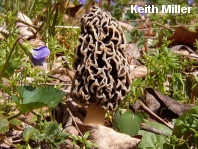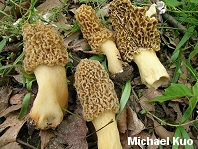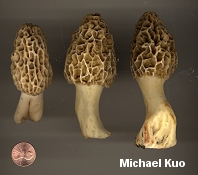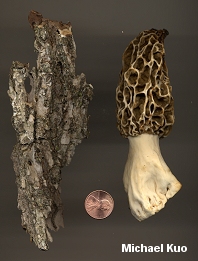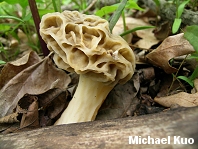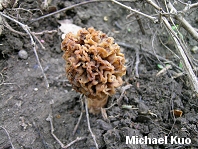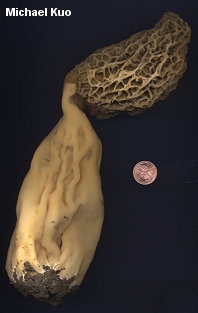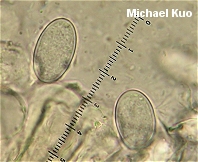| Major Groups > True Morels & Verpas > Morchella esculentoides |

|
Morchella esculentoides [ Ascomycetes > Pezizales > Morchellaceae > Morchella . . . ] by Michael Kuo This is the most widely distributed and common morel in North America, fairly easily identified unless you are in the Great Lakes region (more on that little problem in a moment). Morchella esculentoides is a yellow morel--which means it has ridges that do not darken to brown or black with maturity, and a cap that is attached to the stem without a significant groove or channel. Among the yellow morels it can be distinguished on the basis of its medium to large size, its egg-shaped cap, the random orientation of its pits and ridges, and the fact that its surfaces do not normally bruise reddish when fresh. In western North America Morchella esculentoides appears primarily in riverbottoms, in association with cottonwoods and other hardwoods--or in urban settings, in association with ornamental ash plantings, or apple trees. East of the Rocky Mountains, it can appear almost anywhere where there are trees--but it is especially frequent under dead or dying American elms, and under living white ash and green ash. Unfortunately, from roughly Illinois to Virginia, Ontario, and western Pennsylvania, Morchella esculentoides cannot be reliably separated from the apparently identical Morchella cryptica without DNA testing. Of the two species, Morchella esculentoides is more common within the region, but Morchella cryptica occurs fairly frequently, too. I suspect (but cannot reliably document) that dead-elm collections and orchard collections can safely be assumed to represent Morchella esculentoides. Among the many interesting results from DNA testing of morels sent in to the now closed Morel Data Collection Project were two findings that contradict assumptions made by many Midwestern and eastern North American morel hunters. First, "gray morels" were not supported as separate species; specimens with pale ridges and nearly black pits (see the top illustration) turned out merely to be immature forms of "normal" yellow morels. (The "gray morel" of western North America, however, represents a different concept, which DNA testing determined to correspond to Morchella tomentosa.) The second contradicted assumption involves "Morchella crassipes," in the sense of North American field guide authors, who have sometimes applied that species name to yellow morels with large, inflated stems (see the seventh illustration). Such collections were not supported by DNA testing as separate species; rather, they merely represented very mature specimens that had developed over long periods of time in warm, wet conditions. (Incidentally, the true Morchella crassipes is a European species that awaits a DNA-confirmed contemporary definition.) Description: Ecology: Possibly saprobic and mycorrhizal at different points in its life cycle; growing alone, scattered, or gregariously in a variety of ecosystems: under hardwoods (especially living white ash and green ash, and dead or dying American elm, but also with many other hardwoods), under apple trees in old, untended orchards, and occasionally under conifers; widely distributed and common east of the Rocky Mountains; in western North America common under hardwoods in river bottoms or in urban settings in association with ash or apple plantings; spring (March through June, depending on latitude and altitude). Cap: 2.5-11 (sometimes up to 22) cm tall and 1.5-6 cm wide; usually egg-shaped with a convex or bluntly conical apex, but sometimes nearly round, or more or less cylindrical, or irregular; pitted and ridged, with the pits randomly arranged and oriented; when young with bald, bluntly rounded or nearly flattened, whitish to pale yellowish ridges and grayish brown to dark brown or nearly black pits; when mature with sharpened or eroded, yellowish to brownish yellow or whitish ridges and yellowish to brownish yellow pits; in old age sometimes discoloring reddish brown in places (see the sixth illustration) but not actually bruising reddish when fresh; attached to the stem directly, without a groove; hollow. Stem: 2-12 cm high and 1.5-10 cm wide (but sometimes much larger when left unpicked in warm, wet conditions); usually swollen at the base; whitish to pale yellowish or brownish; bald or finely mealy with granules; hollow (but sometimes becoming somewhat chambered or layered near the base when mature). Microscopic Features: Spores (17-) 18-22 (-24) x 11-13 (-15) µ; smooth; elliptical; without oil droplets; contents homogeneous. Asci 8-spored. Paraphyses cylindric with variable apices; septate; hyaline to ochraceous or brownish in KOH. Elements on sterile ridges 75-160 x 10-37.5 µ; septate; hyaline to ochraceous in KOH; terminal cell widely cylindrical with a rounded, subcapitate, capitate, subclavate, clavate, or subfusiform apex. REFERENCES: M. Kuo, Dewsbury, Moncalvo & S. L. Stephenson in Kuo et al., 2012. (Kuo, 2005; O'Donnell et al., 2011; Kuo et al., 2012.) SPECIMENS EXAMINED: Herb. OSC 138364-138367 (holotype). Herb. F. 05310201, 03250301, 04130302, 04150302, 04180302, 04190303, 04190304, 04200301, 04200308, 04210301, 04230301, 04240302, 04250301, 04270303, 04270304, 04290302, 04290304, 05010301, 05020301, 05020303, 05030302, 05030305, 05030306, 05030307, 05030308, 05030309, 05030312, 05100301, 05100304, 05120301, 05180301, 05220301, 05280301, 05290301, 05290302, 06070301, 03190401, 03220401, 03280402, 03280403, 03310401, 03310402, 04040404, 04040405, 04100402, 04100403, 04100404, 04110401, 04110403, 04230405, 04250401, 04250402, 04250404, 04250405, 04270401, 04280401, 04280403, 05010406, 05020401, 05020403, 05020405, 05030406, 05030407, 05030408, 05040401, 05080401, 05080402, 05080403, 05080404, 05100401, 05130401, 05150401, 05150402, 05160402, 05170401, 05190402, 05220401, 05230402, 05230403, 05240401, 04090501, 04150501, 04160501, 04200501, 04260501, 05070502, 04020601, 05190601. This site contains no information about the edibility or toxicity of mushrooms. |
© MushroomExpert.Com |
|
Cite this page as: Kuo, M. (2012, November). Morchella esculentoides. Retrieved from the MushroomExpert.Com Web site: http://www.mushroomexpert.com/morchella_esculentoides.html. |
